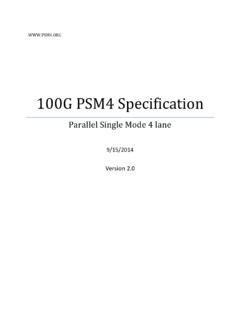Transcription of PASSIVE OPTICAL SPLITTER - Senko Fiber Optic …
1 11 White PaP1 WhittipPrMAY205 WBnA1Pd2 MPLMW34W05 AYMP43 PAM6dP1 MAMW5dn4AP2n12P7 LMM8P5 YYM77 PAMd94WB7 White PaperMAY 2015 PASSIVE OPTICAL SPLITTERB enchmarking the Performance of Next Generation High Speed Access NetworksBernard Lee21 White PaP1 WhittipPrMAY205 WBnA1Pd2 MPLMW34W05 AYMP43 PAM6dP1 MAMW5dn4AP2n12P7 LMM8P5 YYM77 PAMd94WB7 AmericaUSA EAST 1-888-32-SENKOUSA WEST 1-858-623-3300 TEXAS AmericaBRAZIL KONG +852-2121-0516 SHANGHAI +86-21-5830-4513 SHENZHEN +44 (0) 118 982 1600 ITALY +39 011 839 98 28 POLAND + 48 71 396 36 PacificAUSTRALIA +61 (0) 3 East North AfricaDUBAI +971 4 +81 (0) 3 PaP1 WhittipPrMAY205 WBnA1Pd2 MPLMW34W05 AYMP43 PAM6dP1 MAMW5dn4AP2n12P7 LMM8P5 YYM77 PAMd94WB7 ContentsGR-1209 & GR-1221: BENCHMARKING THE PERFORMANCE OF NEXT GENERATION HIGH SPEED ACCESS NETWORKS4567891113151515 Executive SummaryIntroduction to the functionality of an OPTICAL SplitterIntroduction to GR-1209 & GR-1221 Basics of PLC SPLITTER Manufacturing ProcedureKey steps of manufacturing an OPTICAL splitterHow do You Determine the Quality of a PLC SplitterOutline of GR-1221 Test StandardsNon GR-1209 & GR-1221 Certified PLC SplittersSummaryReferencesBiography41 White PaP1 WhittipPrMAY205 WBnA1Pd2 MPLMW34W05 AYMP43 PAM6dP1 MAMW5dn4AP2n12P7 LMM8P5 YYM77 PAMd94WB7In 2012, a leading market and technology analysts announced the Asia Pacific region (APAC) region leads in the consumption of Planar Lightwave Circuit (PLC) SPLITTER compact devices with 68% of the worldwide value, followed by the American region and finally the EMEA region.
2 The increase of mass FTTx PON network deployment dominates the worldwide PLC SPLITTER compact device consumption value in 2012 with 77% in relative market share; followed by the cable TV segment, the PLC splitters used in Test and to market analysis by ElectroniCast Consultants, the sales of PLC splitters reached $ in 2013. PON based FTTH network deployment is dominating the worldwide PLC SPLITTER consumption value in 2014. While the Americas region is forecasted for a flat annual growth of about 1% over the 2013-2018 period, the EMEA is set for a 7% growth per year; and Asia Pacific should increase at 15% per year, for component level PLC splitters. ( ) In PASSIVE OPTICAL Network (PON), OPTICAL splitters play an important role in Fiber to the Home (FTTH) networks by allowing a single PON interface to be shared among many subscribers. Splitters contain no active electronics and does not require any power to operate.
3 OPTICAL Splitters are installed in each OPTICAL network between the PON OPTICAL Line Terminal (OLT ) and the OPTICAL Network Terminals (ONTs) that the OLT serves. Networks implementing BPON, GPON, EPON, 10G EPON, and 10G GPON technologies all uses these simple OPTICAL splitters. Nevertheless, for the experimental WDM-PON, in place of an OPTICAL SPLITTER , an Arrayed WaveGuide (AWG) is being large-scale deployment of FTTx, most SPLITTER modules and other PASSIVE OPTICAL components were installed in central offices where it is in a stable temperature controlled environment. When the number of FTTH deployments increased, the deployment of OPTICAL splitters in the OSP network became a more cost effective solution. The common locations for OPTICAL splitters to be deployed in the OSP are in cabinets, in aerial or underground closures and also in wall-mounted enclosures in a building basement such as a Multi Dwelling Unit (MDU).
4 Hence these splitters need to deliver both OPTICAL and mechanical performance when installed in any of these conditions. This paper describes the relevance of the criteria in the applicable industry specifications, as well as the importance of the physical parameters and how they relate to the performance of the OPTICAL splitters. This paper discusses the importance of quality, reliability, and performance as they relate to industry standards and manufacturing practices covered by the Telcordia GR-1209 requirements and GR-1221 testing procedures pertaining to one of the most important component in the Next Generation Access Networks the PASSIVE OPTICAL Summary51 White PaP1 WhittipPrMAY205 WBnA1Pd2 MPLMW34W05 AYMP43 PAM6dP1 MAMW5dn4AP2n12P7 LMM8P5 YYM77 PAMd94WB7 OLTONTRF Video OLTO ptical TransmitterHeadendOptical AmplifierWDM Coupler1550 nm1490 nm1310nm1310 nm1490 nm1550 nmCATVI ntroduction to the functionality of an OPTICAL SplitterAn OPTICAL SPLITTER is an essential component used in an FTTH PON where a single OPTICAL input is split into multiple output.
5 This enables the deployment a Point to Multi Point (P2MP) physical Fiber network with a single OLT port serving multiple ONTs. The most common split ratios are 1:2, 1:4, 1:8, 1:16 and 1:32. Although other split ratios are available, they are usually custom made and commands a Fiber systems have also begun to replace coax networks which were used to transmit CATV analogue RF signals. Wavelength Division Multiplexer Couplers are used to overlay the 1550nm analogue signal from the CATV digital transmitter at the headend to the 1310nm and 1490nm signal from the PON equipment. The most common splitters deployed in a PON system is a uniform power SPLITTER with a 1:N or 2:N splitting ratio, where N is the number of output ports. The OPTICAL input power is distributed uniformly across all output ports. Splitters with non-uniform power distribution is also available but such splitters are usually custom made and command a premium. The OPTICAL SPLITTER in a PON system functions to share the cost and bandwidth of the OLT among multiple ONTs as well as reduce the Fiber lines required in the OSP.
6 Splitters can be deployed in a centralized splitting configuration or a cascaded splitting configuration depending on the customer distribution. The 1:N splitters are usually deployed in networks with a star configuration while 2:N splitters are usually deployed in networks with a ring configuration to provide physical network redundancy. Star ConfigurationRing Configuration1490nm1310nmONTONTONTONTONT O LTO LTHeadendONTWDM Coupler1490nm1490nm1550nm1550nm1310nmC AT V1310nmRF Video OLTO ptical AmplifierOptical TransmitterO LTO LTO LT61 White PaP1 WhittipPrMAY205 WBnA1Pd2 MPLMW34W05 AYMP43 PAM6dP1 MAMW5dn4AP2n12P7 LMM8P5 YYM77 PAMd94WB7An introduction to GR s history and objective of implementation of the standard. Also touch on evolution of the standards (recently added requirements for anti-fungus)Telcordia GR1209 & GR-1221 standards outline the generic criteria for PASSIVE OPTICAL components to ensure continuous operation of the components over its lifetime.
7 The standards specify performance tests to reflect a composite picture of various conditions. These compliance tests cover three main features of an OPTICAL SPLITTER which are the general requirements for an outside plant component, the functional design criteria and its performance criteria. The environmental and mechanical tests outlined in the GR-1209 standard is designed to demonstrate the short term operational performance of a PASSIVE OPTICAL component. The normal lifespan of an FTTH network is at least 25 years, thus it is recommended for the environmental and mechanical test criteria to be based on the GR-1221 performance tests are intended to reflect a composite picture of various conditions. The generic criteria, desired features and test methods may be subject to change. Such changes or addition is done to enhance the reliability criteria of the PASSIVE component under test. An example of such an update is the inclusion of an anti-fungus test in the GR-1209 test standard.
8 Introduction to GR-1209 & GR-122171 White PaP1 WhittipPrMAY205 WBnA1Pd2 MPLMW34W05 AYMP43 PAM6dP1 MAMW5dn4AP2n12P7 LMM8P5 YYM77 PAMd94WB7 Basics of PLC SPLITTER Manufacturing ProcedureAmong the many miniature parts which makes up a PASSIVE OPTICAL PLC SPLITTER , there are three main components which are the Fiber array for the input and output, and the chip. The design and assembly of these three component is the key to produce a high quality PLC SPLITTER . Fiber Array V-GrooveFiber Array LidInput Fiber ArrayOutput Fiber ArrayInterface SPLITTER Chip/ Fiber ArrayRibbon FiberEpoxyEpoxySplitter ChipEnd Cap bootEnd Cap bootOuter Housing81 White PaP1 WhittipPrMAY205 WBnA1Pd2 MPLMW34W05 AYMP43 PAM6dP1 MAMW5dn4AP2n12P7 LMM8P5 YYM77 PAMd94WB7 Components PreparationThe PLC circuit chip is designed and embedded on a piece of glass wafer. Each end of the glass wafer is polished to ensure high precision flat surface and high purity. The v-grooves are then grinded onto a glass substrate.
9 A single Fiber or multiple ribbon Fiber is assembled onto the glass substrate. This assembly is then the preparation of the three components, they are set onto an aligner stage. The input and output Fiber array is set on a goniometer stage to align with the PLC chip. Physical alignment between the Fiber arrays and the chip is monitored through a continuous power level output from the Fiber array. Epoxy is then applied to the Fiber array and the chip to affix their assembly is then placed in a UV chamber where it will be fully cured at a controlled temperature. PackagingThe bare SPLITTER is aligned and assembled into a metal housing where Fiber boots are set on both ends of the assembly. A temperature cycling test is done for a final screening to ensure the final product condition. OPTICAL TestingOptical testing such as Insertion Loss, Uniformity and Polarization Dependent Loss (PDL) is performed on the SPLITTER to ensure compliance to the OPTICAL parameters of the manufactured SPLITTER in accordance to the GR-1209 CORE specification.
10 The following section outlines the key steps of manufacturing an OPTICAL SPLITTER where each step requires strict Quality Control on the environment, equipment used and also detailed precision in alignment and assembly. Key steps of manufacturing an OPTICAL splitterStep1 Step2 Step3 Step4 Step5 9GR-1209 & GR-1221: BENCHMARKING THE PERFORMANCE OF NEXT GENERATION HIGH SPEED ACCESS NETWORKSHow do You Determine the Quality of a PLC SPLITTER OPTICAL BandpassThe GR-1209 standard provides comprehensive OPTICAL performance criteria for a PASSIVE OPTICAL SPLITTER . There are six main specification that is outlined in this standard. The following section outlines each of the specification and their importance for a fully functional OPTICAL PON system has a downstream transmission using the 1490nm wavelength while the upstream transmission is a 1310nm wavelength. In addition, there needs to be consideration for any requirement for RF video overlay and network testing/maintenance.
















